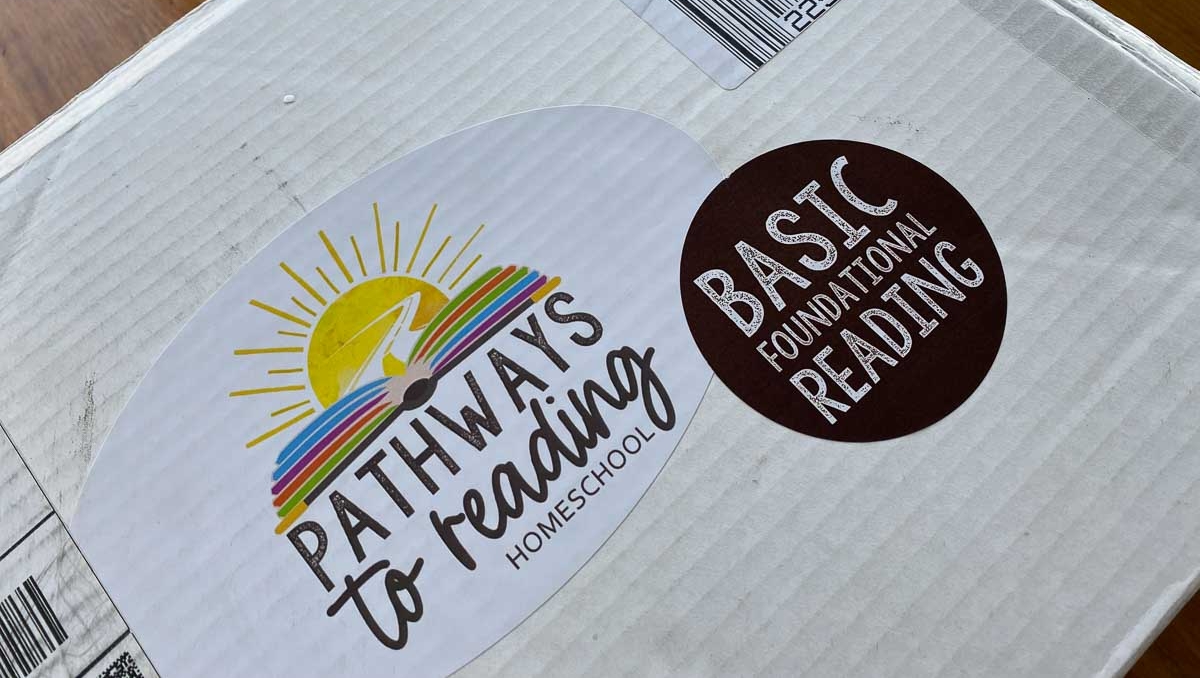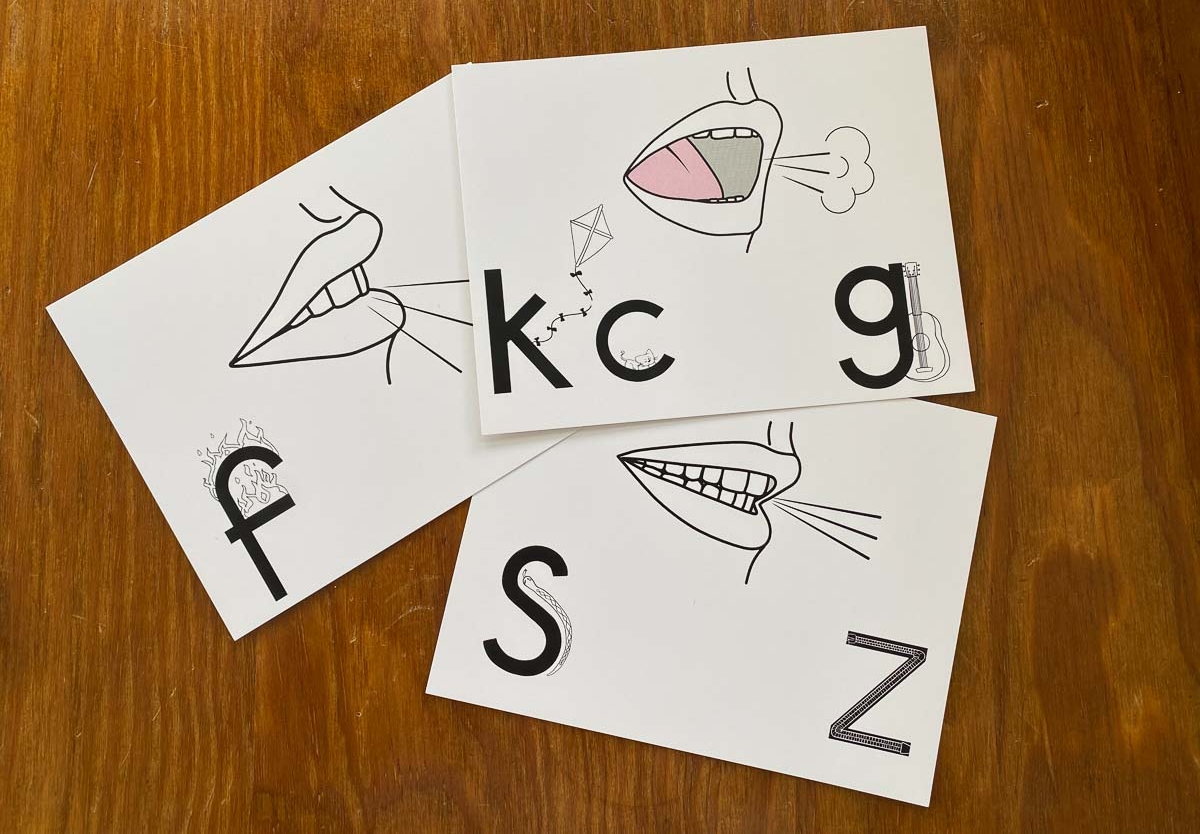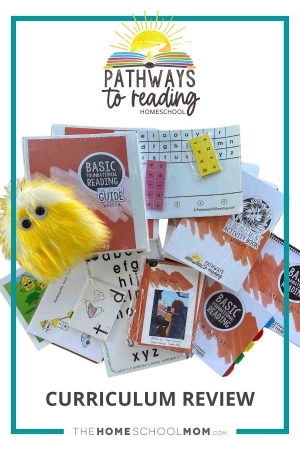Having a beginning reader is so exciting, but the responsibility to help them learn can sometimes feel overwhelming to homeschool parents.
What if you got everything you need to teach reading in one box, along with videos and digital resources to help you become the best possible reading teacher for your child?
That's what we found in Pathways to Reading Homeschool!

This program is set up for more learning and less overwhelm-and designed for use right in your own home.
We reviewed Pathways to Learning Homeschool's Basic Foundational Reading Curriculum, which is aimed at kindergartners. They also have a first grade program, Proficient Foundational Reading Curriculum.
Is phonics included?
Let's start with the basics. The science of reading has been in the news a lot lately. Some schools have not been emphasizing phonemic awareness and phonics with their beginning readers, which many experts say are vital for most kids to learn to read. We know a lot of school children struggle to read, and a lack of systematic instruction in phonics may be one reason why.
Pathways to Reading Homeschool does teach phonemic awareness and phonics, and the program has been used in schools around the country even when many other school divisions had let go of that important instruction.
Pathways to Reading has been perking right along in schools, even training classroom teachers to give step-by-step reading instruction in a systematic way-just as reading experts say is needed by most young readers.
And here's what happened-one of the teachers who saw much success in her school classroom with Pathways to Reading started homeschooling her own child-and with a cooperative effort from the author of the program-has now created Pathways to Reading Homeschool.
Pathways to Reading Homeschool is the best of both worlds. The program has high quality materials and training like teachers use in a classroom, but the program has been adjusted to make it easy to implement by homeschool parents.
What comes in the box?
What comes in the box? The kit contains everything you need!
The biggest component is the open and go Home Educator's Guide, which contains scripted lessons that go with video resources you watch with your child.

Here is what is in the the Basics (kindergarten level) kit:
- Home Educator's Guides (there is so much goodness included that the Home Educator's Guide fills two extra large binders, one for weeks 1-18 and one for weeks 19-32)
- Spiral-bound reinforcement activity books (including crafts, worksheets, handwriting opportunities, and more)
- Magnetic letter board with consonant and vowel magnets that is custom-designed to go with the lessons
- Flip & Assist booklet
- Decodable sentence strips
- Double-sided ABC Chart
- Mouth articulation pictures with mnemonic (pictured below)
- Vowel Hill and Vowel Town
- Transparent arrow for assists
- 14 decodable books that are unique to the program (and again, they match the lessons exactly)
- Screech the puppet
Screech, the puppet that comes in the box, makes an appearance in some of the videos. His presence creates warmth and continuity between watching the videos and learning the concepts at home.
We always appreciate when curriculum manages to provide a positive emotional context that helps children learn.
What did we love?
One of the things that really stood out to us was the careful presentation of articulation. Lots of us have helped kids "sound out" words. But Pathways to Reading Homeschool also helps kids recognize and practice how letter sounds are made by the teeth, lips, tongue-and even the nose. This really helps kids distinguish one sound from another.
And the thing is, they've prepared all this so parents just have to use the already-printed mouth picture cards with the provided videos. You'll find yourself trying to make all the sounds and thinking about the shape of your mouth right alongside your child.

Which brings us to two more things.
First, even though there are different physical components to this program, it's not as fiddly as other programs we've tried. You don't have to cut out letters or cards or prep a lot of materials just to teach the lessons. Everything is ready for you. Yes, the full kit includes supplemental craft ideas and activities, but each lesson can be taught using the materials already provided.
Perfect for a busy parent-but with enrichment and assistance when you need it.
And second? You will learn stuff you didn't know as you use this program-and you'll enjoy it. The first videos you have access to amount to a master class in reading instruction if you're interested, but even if you don't watch those (they're considered optional), you'll feel lightbulb moments over and over as you go through the lessons with your child.
We homeschooling parents recognize this feeling from when we've used other good curricula, like suddenly understanding a mathematical concept or getting a history timeline straight for the first time-things we "should" have learned in school years ago.
Will it help struggling readers?
Pathways to Reading Homeschool is based on Orton-Gillingham instruction, which is considered the best approach for struggling readers, including for children who have dyslexia.
Is there support?
Now let's talk support. They've got it all.
- The member area of the website gives you well-organized access to digital resources including videos (for parents and for parent and kids to watch together), downloadable PowerPoint files, and downloadable PDFs to guide you in having "family book clubs."
- They have a Facebook group for parents-with live webinars!
- They have a member only discussion area on their website.
- They offer to personally answer parents' questions.
And honestly, the way the curriculum kit's materials are interwoven, they create their own net of support with extra assists and other angles of instruction right when you need them.
Is it flexible?
Pathways to Reading Homeschool can be used flexibly. For example, the materials mention that the lessons will take about 35 minutes a day, but they also advise you could break the lesson into a few parts and spread them out over the day-as homeschoolers so often do, especially with our littles.
We'd suggest similar flexibility as you do the recommended pre-assessments, which ask parents to use a stopwatch as children identify letters. Typically, homeschool parents have lots of one-on-one time with their kids and would know-or could know with just a little informal effort-which letters their kids recognize with immediacy.
Homeschool parents working with one or two kids instead of a class full of kids would also typically know exactly when new letters and sounds are mastered.
The goal behind the assessments is great-but if a stopwatch feels like it would add too much pressure for your particular child or not fit your homeschool environment, use your judgment.
When a program has thought of everything you need to think about, every concept you need to teach, and every material you might need to teach it, we're happy to make that kind of judgment call (no stopwatch at our house!) and luxuriate in having every lesson perfectly prepared.
Another place the program is flexible is in which level ("Basic" or "Proficient") to use. While the two levels are roughly aimed at kindergarten and first grade, the program authors provide a list of prerequisites to help you determine which program your child would benefit from the most. (Scroll to the bottom of the Proficient page to see the prerequisites for the first grade level).
Parents with sensitive kids will appreciate that "kindergarten" is not stamped all over the Basic materials, so if you need to spend more time mastering those skills, you can smoothly continue with Basic during your child's first grade year. Kids learn at their own pace!
The program is also multi-sensory, which means there is flexibility because different ways of learning are always offered.
Pathways to Reading Homeschool truly provides "teach-the-teacher" hand holding you're looking for along with the exact nuts and bolts you need to teach your child to read.
TL;DR
Pathways to Reading Homeschool is the best of both worlds. The program has high quality materials and training like teachers use in a classroom, but the program has been adjusted to make it easy to implement by homeschool parents.
Find more information about Pathways to Reading Homeschool at their website.





Leave a Reply